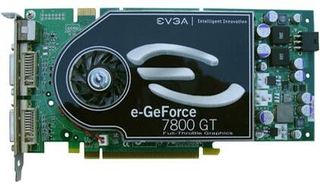EVGA 7800GT
An alternative to the ATI is the eVGA e-GeForce 7800 GT.

As a graphics industry leader and trendsetter, nVidia poses a formidable threat to ATI on the graphics card front. Already equipped with dual graphics capability via its own patented Scalable Link Interface (SLI) technology since the 6000 series, nVidia continues to push the envelope to better meet the needs of resource-hungry applications. The flagship 7800 series next-generation GPU architectures set the pace for things to come.
GeForce 7800 chipsets arrive in two forms: the 7800 GT and GTX. The GT form boasts a 400 MHz core clock with 1 GHz memory speed, 7 vertex units and a 20-pixel pipeline scheme. In GTX trim, the 7800 upgrades the core clock by 30 MHz, increases the memory bus to 600 MHz, adds a vertex unit for a total of 8, and provides an additional 4 pixel pipelines. Both feature 64 bit floating point texture filtering and blending, 128 bit studio precision calculations, a 256 bit memory interface, and dual 400 MHz RAMDACs.
eVGA's latest offering of the 7800 GT features a 470 MHz core paired with a 550 MHz memory clock, reportedly the fastest on the market. The version supplied from the vendor (P/N: 256-P2-N517-AX) utilizes a copper heatsink mated with a single blower-type fan, and a shell that directs airflow across the block with exhaust toward the front of the case. When used in tandem with an SLI setup, both blower fans do add considerable noise to the build, but that's to be expected when one aims at the high end of computing.
These 7800s come with an integrated TV encoder that supports Video-In/Video-Out (VIVO) with dual DVI-I, composite in and S-Video out for HDTV home theater use. You can output video imagery directly using nVidia's image quality software suite, or toggle quickly between various output types using nVidia's task bar.
On the software side, eVGA's 7800 GT supports the latest in DirectX 9.0c with Shader Model 3.0, compared to ATI's DirectX 9.0, Shader Model 2.0 support. It also supports OpenGL 2.0 and nVidia's UltraShadow II, Digital Vibrance Control 3.0, PureVideo, CineFX 4.0 and the ever useful nView multi-display technology (handy for multi-monitor and multi-GPU purposes). Of course, all nVidia drivers adhere to their Unified Driver Architecture (UDA), which means hassle-free rapid deployment.
What can be said about the performance difference could fill volumes; it's better experienced than read about. A single 7800 GT can outperform a pair of 6800 GTs in tandem, to give you an idea. Use a pair of 7800s to raise the bar on high-end games, and really put yourself into the action. Go ahead, get yourself (or someone on your wish list, if you've got the bankroll) one or two eVGA GeForce 7800 GT CO cards from. (MSRP $469)
Stay on the Cutting Edge
Join the experts who read Tom's Hardware for the inside track on enthusiast PC tech news — and have for over 25 years. We'll send breaking news and in-depth reviews of CPUs, GPUs, AI, maker hardware and more straight to your inbox.
Ed Tittel is a long-time IT writer, researcher and consultant, and occasional contributor to Tom’s Hardware. A Windows Insider MVP since 2018, he likes to cover OS-related driver, troubleshooting, and security topics.
Most Popular


